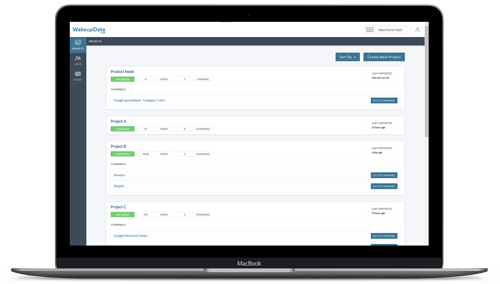Mastering Product Feed Optimisation Across All Marketing Channels Q&A
Posted on April 30, 2024 (Last Updated: May 02, 2024)
Join us as our Customer Success Team Lead at WakeupData delves into the strategies that propel successful multi-channel marketing efforts and how to navigate the complex world of product feed optimization.
The importance of effectively managing product feeds cannot be overstated.
With platforms like TikTok, Meta, and Google Shopping dominating the landscape, each one requires a tailored approach to ensure your products not only appear but also perform.
Join us as our Customer Success Team Lead at WakeupData dives into the strategies that drive successful multi-channel marketing efforts and navigate the complex world of product feed optimization. From the complexities of algorithmic nuances to the strict requirements of platform-specific feeds, the challenges are as varied as the opportunities they present.
Interesting Fact: Did you know that product feeds influence more than 30% of e-commerce sales? Tailoring these feeds to different platforms can increase conversion rates by up to 20%, highlighting the critical role of targeted feed optimization.
You can watch the interviews below.
Q1: Why is it advised against using one universal feed for all marketing channels?
Team Lead: Utilizing a single feed across multiple platforms often leads to operational inefficiencies and performance issues. Each channel has its own set of technical standards and audience expectations. Customizing feeds accordingly ensures that they resonate well with the target audience of each platform, thereby reducing the risk of feed rejection and maximizing engagement.
Interesting Fact: Customizing product feeds for different marketing channels can increase engagement rates by up to 50%. Tailoring content to the specific requirements and user base of each channel not only minimizes the likelihood of feed rejection but also significantly boosts the performance of marketing campaigns. This customization involves adjusting aspects like image sizes, product descriptions, and metadata to meet the unique standards of platforms such as Google Shopping, Facebook, or Pinterest.
Q2: What are some common pitfalls in managing a multi-channel feed strategy?
Team Lead: One of the main pitfalls is overlooking the specific content and format requirements of each channel, which can lead to suboptimal product visibility and engagement. Another challenge is maintaining up-to-date inventory information across channels, which is crucial to avoid overselling or underselling scenarios.
Interesting Fact: Nearly 30% of retailers experience inventory discrepancies due to challenges in synchronizing multi-channel feeds. This often results in significant operational challenges, including the risk of overselling or underselling products. Effective management and real-time updates of inventory across all channels are crucial to mitigate these discrepancies and maintain customer satisfaction and trust.
Q3: Could you describe a challenging scenario where you had to optimize a product feed for multiple channels?
Team Lead: A notable challenge was when we worked with a client who needed to optimize their feed for both Amazon and Facebook. The stark contrast in their image requirements—Amazon requiring clean, white backgrounds without any promotional text, versus Facebook, which favors visually rich images with text overlays—required a strategic approach. We used conditional formatting and segmentation within our feed management tool to customize the content for each channel without duplicating effort.
Interesting Fact: Implementing conditional formatting in product feed management can reduce the time spent on feed customization by up to 40%. By using advanced tools that allow for conditional formatting and segmentation, businesses can effectively tailor their product images and descriptions to meet diverse channel requirements, such as those of Amazon and Facebook. This approach streamlines operations and significantly reduces the manual effort needed to manage multiple feeds effectively.
Q4: How do you ensure that product feeds are updated in real-time or as frequently as necessary?
Team Lead: Our system is designed to pull data from client inventories in real-time. This means any change in the product catalogue is instantly reflected in the feeds sent to various channels. For channels that require less frequent updates, we use scheduled tasks to ensure the feed is as updated as the platform allows, maintaining the accuracy and relevance of product listings.
Check our near real-time updates add-on.
Interesting Fact: Utilizing real-time data synchronization for product feeds can increase inventory accuracy by over 95%. By implementing systems that instantly reflect changes in the product catalogue across various channels, businesses can maintain high levels of accuracy and relevance in their product listings. This method minimizes issues like overstocking or stock-outs, improving overall operational efficiency and customer satisfaction.
Q5: What specific attributes do you prioritize when optimizing feeds for Google Shopping’s algorithm?
Team Lead: Apart from the fundamental attributes like titles and descriptions, we focus heavily on GTINs (Global Trade Item Numbers) and brand identifiers, which significantly improve product discoverability in Google Shopping. Also, high-quality images and precise categorization align with Google's best practices to enhance product visibility and click-through rates.
Interesting Fact: Including GTINs (Global Trade Item Numbers) in product feeds can increase visibility in Google Shopping search results by up to 40%. By focusing on essential attributes such as GTINs and brand identifiers, along with ensuring high-quality images and precise categorization, businesses can significantly enhance product discoverability. These practices align with Google's algorithms and best practices, leading to improved product visibility and higher click-through rates.
Q6: Can you discuss the importance of A/B testing in feed optimization and provide an example of a successful test?
Team Lead: A/B testing is fundamental to understanding what resonates best with your audience. For example, we conducted a test where we changed the color and size of the price font in a client's feed for a fashion retailer. The variant with a bolder and slightly larger font size saw a 15% increase in click-through rates, proving the impact of seemingly minor details on customer engagement.
Interesting Fact: A/B testing minor visual elements in product feeds, such as font size and colour, can lead to an increase in click-through rates by up to 15%. This approach demonstrates how subtle changes, even those that might appear insignificant at first glance, can significantly influence customer behaviour and engagement. Effective A/B testing allows businesses to scientifically determine what adjustments in their product presentations yield the best outcomes, optimizing their marketing strategies accordingly.
Q7: What are your strategies for managing and optimizing large-scale product feeds?
Team Lead: We use a combination of rule-based automation and machine learning algorithms to manage feeds with thousands of SKUs. This allows us to automatically categorize products, optimize descriptions, and update prices in real-time, ensuring the feed remains both accurate and optimized for performance.
Interesting Fact: Implementing rule-based automation combined with machine learning algorithms can enhance the management of product feeds by 50%, ensuring they are continually optimized for performance. These technologies allow for the automated categorization of products, optimization of descriptions, and real-time price updates, handling thousands of SKUs efficiently. This approach not only maintains the accuracy of the feeds but also boosts their effectiveness in driving sales.
Q8: Should the content of each feed be tailored specifically to different channels?
Team Lead: Absolutely. Each platform engages its audience in unique ways. For instance, a feed tailored for Pinterest should focus on inspirational and visually appealing images because it’s a visual search engine, while a feed for Google Shopping should concentrate on providing detailed product specifications and competitive pricing.
Interesting Fact: Customizing product feeds to suit the unique characteristics of platforms like Pinterest and Google Shopping can improve engagement rates by up to 70%. Tailoring feeds for a visual search engine like Pinterest involves focusing on inspirational and visually appealing images, while for Google Shopping, it's crucial to emphasize detailed product specifications and competitive pricing. This strategy ensures that the content resonates well with the specific audience of each channel, maximizing both engagement and conversion rates. Check all of the platforms we have direct integrations to here.
Q9: How do you effectively communicate complex feed optimizations to stakeholders who might not be technically savvy?
Team Lead: We focus on the outcomes of feed optimizations and use visual aids and simplified presentations that highlight the benefits, such as increased sales or improved ROI, without delving deep into the technical details. This approach helps stakeholders appreciate the value of optimizations without getting overwhelmed by the complexity.
Interesting Fact: Using visual aids and simplified presentations to explain complex feed optimizations can increase stakeholder understanding and approval rates by up to 60%. This method effectively conveys the benefits such as increased sales or improved ROI, enabling stakeholders to appreciate the value of the optimizations without needing to grasp the intricate technical details. This approach not only facilitates clearer communication but also enhances decision-making processes within organizations.
Q10: Should you target different customer types in each channel then?
Absolutely, targeting different customer segments based on demographics and search behaviours maximizes relevance and conversion rates.
Interesting Fact: Tailoring marketing strategies to specific customer demographics and search behaviours on different channels can enhance conversion rates by up to 50%. This approach ensures that each campaign is highly relevant to its audience, maximizing the likelihood of engagement and purchase. By understanding and addressing the unique preferences and behaviours of different customer types, businesses can significantly improve the effectiveness of their marketing efforts across various platforms.
Navigating the world of product feeds across multiple marketing channels can seem daunting, but with the right strategies and tools, it becomes a powerful lever to pull for boosting online visibility and sales.
By understanding the unique requirements of each platform and continuously testing and refining your approach, your brand can not only meet but exceed the expectations of today’s digital shoppers.
Stay efficient!
P.S. We are geeky and nerdy and thus love to share knowledge with our audience so do not hesitate to contact us for more information on anything feed-related through our social media channels or contact information.
Book a short meeting with us and let's talk business.





